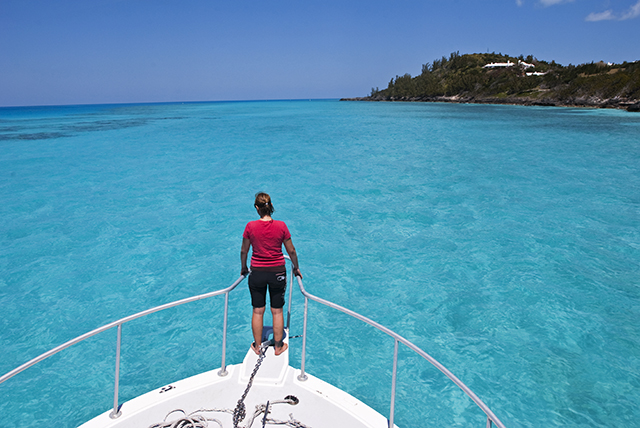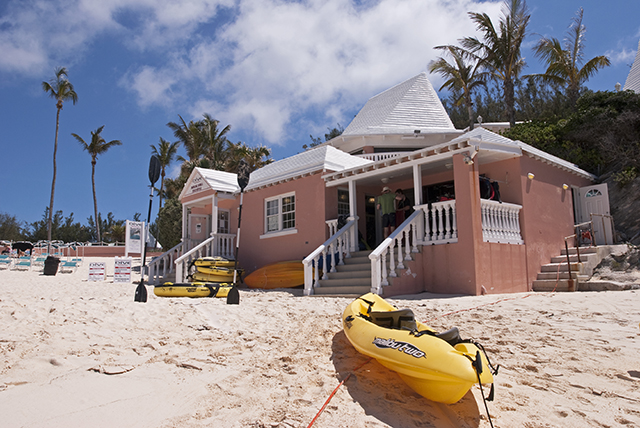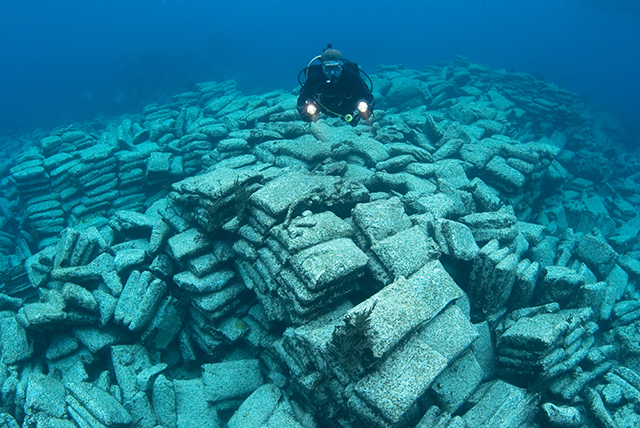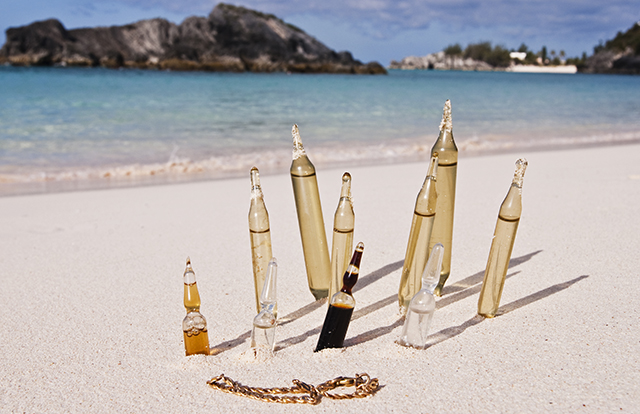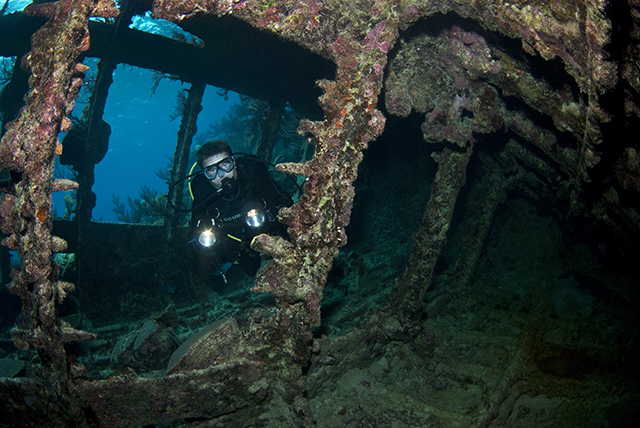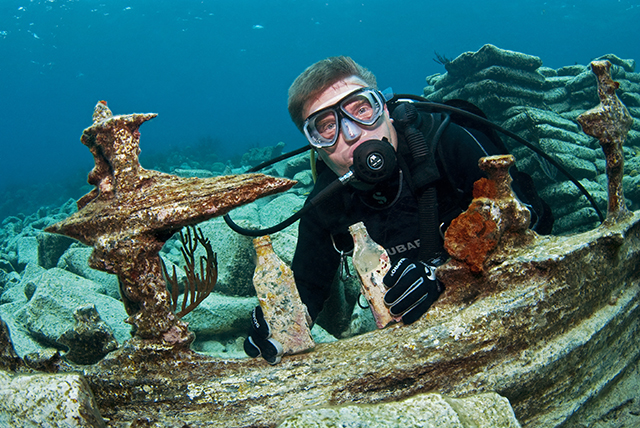News
Bermuda: Wrecks, Wet T-Shirts and Hidden Treasures
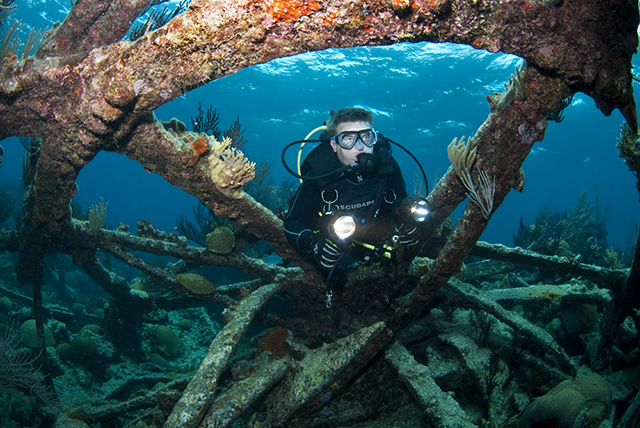
‘Down deep inside there’s a place in me I’m yearning to explore’ – Listening to the late Donna Summer’s sexy dance tune playing on the radio stirred some fond memories. Down Deep Inside was the original soundtrack for the 1977 underwater adventure flick, The Deep. I had been way too young to watch the film when it was first released, which I might add had been given a 15 rating probably due to English actress Jacqeline Bisset’s opening scenes wearing nothing more than a skimpy bikini bottom and a thin wet t-shirt. Looking back this was quite risqué for the 70’s.
The movie, based on American author Peter Benchley’s second novel, turned out to be one of the top 10 grossing films of the year (thanks to Miss Bisset’s cleavage). The basic storyline follows the underwater exploits of Nick Nolte as David Sanders and Jacqeline Bisset as Gail Berke on the island of Bermuda. The loved up couple are seen exploring the remains of a sunken shipwreck. While digging about on the seabed they find a number of items including an old table fork, padlock, cigarette lighter, Spanish medallion and a small 7.5 cm glass vile containing an unknown substance.
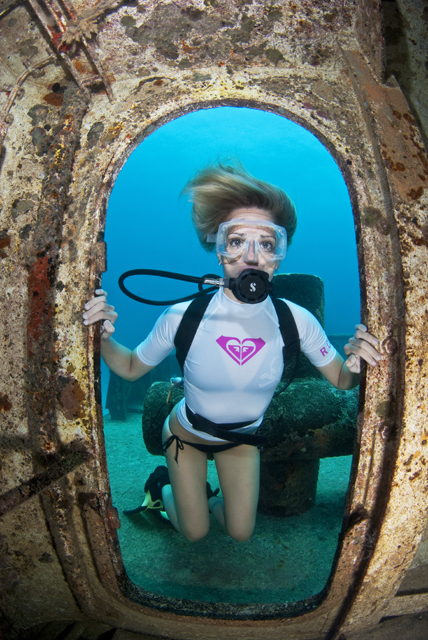 After the dive they search for more information about their ‘finds’ at the local library. David sees a photograph of local treasure hunter Romer Treece played by Robert Shaw (aka shark hunter Quint in the film based on Benchley’s first book Jaws) and thinks he would be a good source of information. Mounting mopeds David and Gail head for Treece’s lighthouse located on St David’s Island at the north eastern tip of Bermuda. Treece is not really interested in helping them out until he catches sight of the small glass vile. This turns out to be a morphine ampoule from the infamous wreck of the Goliath, a WWII military ship that was carrying medical supplies and munitions. Over the years 5 divers had been blown up by the live ammunition stacked inside her holds and nobody had ever seen an ampoule. The island had recently experienced one of the worst storms in 10 years which must have repositioned the wreck and opened up her cargo holds.
After the dive they search for more information about their ‘finds’ at the local library. David sees a photograph of local treasure hunter Romer Treece played by Robert Shaw (aka shark hunter Quint in the film based on Benchley’s first book Jaws) and thinks he would be a good source of information. Mounting mopeds David and Gail head for Treece’s lighthouse located on St David’s Island at the north eastern tip of Bermuda. Treece is not really interested in helping them out until he catches sight of the small glass vile. This turns out to be a morphine ampoule from the infamous wreck of the Goliath, a WWII military ship that was carrying medical supplies and munitions. Over the years 5 divers had been blown up by the live ammunition stacked inside her holds and nobody had ever seen an ampoule. The island had recently experienced one of the worst storms in 10 years which must have repositioned the wreck and opened up her cargo holds.
Just too make the story even more interesting, the Goliath happens to be sitting smack bang on top of an old Spanish Galleon full of priceless treasure. Henri Cloche, a Haitian drug dealer played by Louis Gossett Jr, is the bad guy. He finds out about the huge stash of 98,000 morphine ampoules and intends to get his grubby hands on the merchandise by any means foul. Meanwhile Treece aided by David and Gail set out to retrieve the treasure and blow up the drugs. The second best bit of the movie is seeing Cloche’s head being crunched by a monster sized moray eel lurking inside the Goliath’s holds. There are also plenty of sharks, voodoo, underwater explosions and speargun fights; this old movie really is quality Sunday afternoon entertainment.
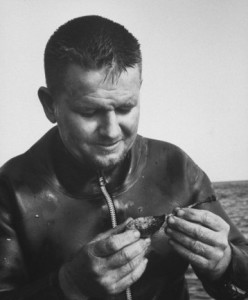 Peter Benchley’s novel was actually based around the true life exploits of his good friend, scuba diver and treasure hunter Teddy Tucker. The role of Romer Treece was basically an extension of Teddy’s real character. Benchley even managed to find a small role for Teddy in the movie (watch out for the Harbour Master!).
Peter Benchley’s novel was actually based around the true life exploits of his good friend, scuba diver and treasure hunter Teddy Tucker. The role of Romer Treece was basically an extension of Teddy’s real character. Benchley even managed to find a small role for Teddy in the movie (watch out for the Harbour Master!).
For the past 50 years Teddy has been involved in wreck research, salvage and excavation. At the grand old age of 87 he can still be found scuba diving off Bermuda. Many of the local wreck discoveries are attributed to Teddy’s diligent work. Bermuda is known as the wreck capital of the Atlantic with more than 300 historical wrecks scattered around the coastline. Most of these sites are above 20 metres so divers have plenty of time for exploration with minimal risk of decompression.
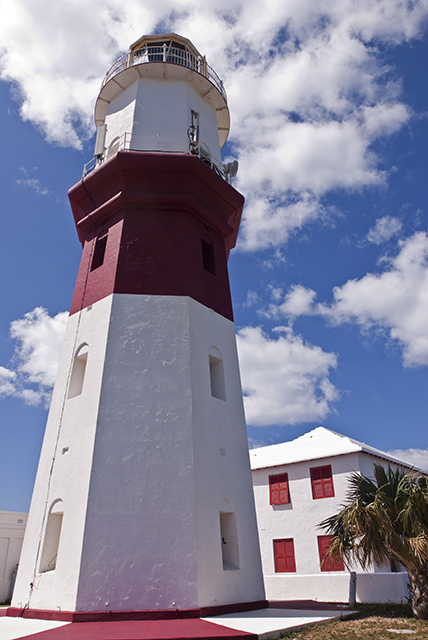 The Deep was shot on location in Bermuda. Romer Treece’s lighthouse is still on St David’s Island. Unfortunately it was closed during my visit so I couldn’t climb the spiral stairway up to the lamp room and admire the sea view. The majority of underwater footage was taken on the wreck of the Constellation and the neighbouring wreck of the Montana located off the north-west coast. I took a taxi ride over to Dive Bermuda, a PADI 5 star IDC centre, and made the arrangements to dive on the 2 wrecks. Dive Bermuda’s manager, Kevin Luton, paired me up with ex-pat Alan Pearce. Sadly there was no sign of any bikini clad women wearing wet t-shirts so I had to make do with Alan in my photographs.
The Deep was shot on location in Bermuda. Romer Treece’s lighthouse is still on St David’s Island. Unfortunately it was closed during my visit so I couldn’t climb the spiral stairway up to the lamp room and admire the sea view. The majority of underwater footage was taken on the wreck of the Constellation and the neighbouring wreck of the Montana located off the north-west coast. I took a taxi ride over to Dive Bermuda, a PADI 5 star IDC centre, and made the arrangements to dive on the 2 wrecks. Dive Bermuda’s manager, Kevin Luton, paired me up with ex-pat Alan Pearce. Sadly there was no sign of any bikini clad women wearing wet t-shirts so I had to make do with Alan in my photographs.
The 4 masted Schooner Constellation set sail from New York on July 19th 1943 bound for Venezuela. She carried 2,000 tons of general cargo including building materials and 300 cases of Whisky. The ship began to take on water so diverted to Bermuda for repair work. On July 31st she hit the reef and sank while trying to find the harbour entrance. All crew members survived the ordeal. A salvage company managed to retrieve some of the cargo and sell it at public auction in Hamilton, the capital, but a considerable amount remained undisturbed on the seabed. The Navy also got involved but they only took the 300 cases of Whisky!
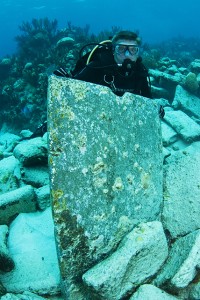
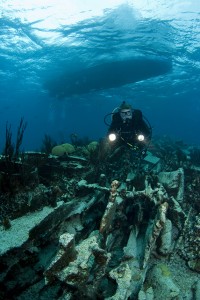 We jumped into the water and dropped down onto a massive pile of 20 kg cement bags. There must have been thousands lying over the seabed. Alan disappeared behind part of the wooden hull and pulled out 2 small glass bottles that must have been part of the cargo. They were quite plain looking designs so probably weren’t carrying anything particularly special. Most of the overlying super structure had long since disintegrated. I couldn’t see any swim throughs or cargo holds to explore. In fact it didn’t look anything like the wreck used in the movie. Alan pointed at a rectangular shaped piece of rock which on closer inspection turned out to be a snooker table slate complete with scalloped corner pockets. I passed over the cement bags and down to a pile of glass windows all stuck together. Inquisitive Parrot fish, Trumpet fish and Sergeant Majors followed us through the wreckage. Maximum depth was around 12 metres so there was plenty of ambient light and the underwater visibility topped 30 metres.
We jumped into the water and dropped down onto a massive pile of 20 kg cement bags. There must have been thousands lying over the seabed. Alan disappeared behind part of the wooden hull and pulled out 2 small glass bottles that must have been part of the cargo. They were quite plain looking designs so probably weren’t carrying anything particularly special. Most of the overlying super structure had long since disintegrated. I couldn’t see any swim throughs or cargo holds to explore. In fact it didn’t look anything like the wreck used in the movie. Alan pointed at a rectangular shaped piece of rock which on closer inspection turned out to be a snooker table slate complete with scalloped corner pockets. I passed over the cement bags and down to a pile of glass windows all stuck together. Inquisitive Parrot fish, Trumpet fish and Sergeant Majors followed us through the wreckage. Maximum depth was around 12 metres so there was plenty of ambient light and the underwater visibility topped 30 metres.
The morphine ampoules were not just a fictitious storyline. The Constellation had actually been carrying a large consignment of medical supplies. Before the dive I was shown a variety of ornate looking glass ampoules that had been found at the wreck site. They were all different shapes, sizes and colours. I was told that the ampoules had been filled with different drugs like iodine, penicillin, insulin, adrenaline as well as morphine. I peered underneath the wreckage and wondered if this was where Jacqeline Bisset had been filmed with the first ampoule in her hand. We passed over some wooden remains held together with jagged metal pins. I stopped briefly by a row of chemical drums and wondered what they had been carrying. I made a mental note to check out Teddy’s new treasure book. There was a complete chapter on the Constellation with details of her entire manifest. Then we were on the wreck of the Montana.
The 60 metre long paddle steamer/gunboat Montana was used as a Confederate blockade runner during the civil war. She made frequent runs from North Carolina to Bermuda and then across the Atlantic to England. In December 1863 the ship was returning from England with a full cargo when she hit a reef and sank off Bermuda. I’m not sure if any scenes from The Deep were filmed on the Montana but the wreckage was far better suited for penetration shots. Alan guided me over to the skeletal remains of the giant paddle wheels adorned with soft and hard corals. The bow was the only overhead section I could find. I managed to fire off a few action shots of Alan peering into the hold before the silt, disturbed by our exhaled bubbles, rained down on top of us. As we made our way back to the surface my thoughts returned to the monster moray eel that had munched on Cloche’s head. I wondered if a family descendent was lurking somewhere in the shadows below. I had kept a wary eye open but saw nothing. Even the sight of my camera hadn’t stirred a reaction.
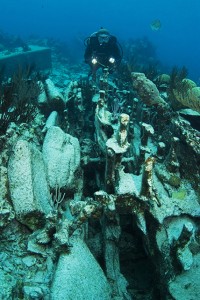
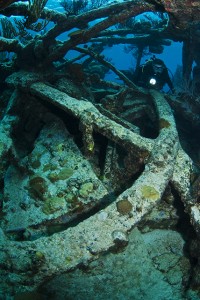 Dive Bermuda’s boat skipper, Heinz, told me that the best time for treasure hunting is after a storm front has passed. The sandy seabed can shift around dramatically revealing parts of wrecks never seen before. Heinz told me about the paddle steamer Marie Celeste. The ship was well broken up with only the bow, paddle wheels and boilers proud of the seabed. A huge storm hit in July 2011 uncovering bottles of wine and other rare artefacts.
Dive Bermuda’s boat skipper, Heinz, told me that the best time for treasure hunting is after a storm front has passed. The sandy seabed can shift around dramatically revealing parts of wrecks never seen before. Heinz told me about the paddle steamer Marie Celeste. The ship was well broken up with only the bow, paddle wheels and boilers proud of the seabed. A huge storm hit in July 2011 uncovering bottles of wine and other rare artefacts.
Maybe the legendary Teddy Tucker hasn’t found all the shipwrecks around Bermuda. There could still be an uncharted Spanish galleon lying on the seabed just waiting for the next big storm to uncover her priceless cargo. All it would take is a young couple on holiday, scuba diving, another wet t-shirt, and who knows, fiction could well become reality.
News
Book Review: Fire on Monroe Bravo by Fred Lockwood

Fire on Monroe Bravo is the latest book in the Jack Collier series by Fred Lockwood. Our story begins with our lead characters, Jack and Sandro, owners of Marine Salvage & Investigation Company, arriving on the Monroe Bravo Oil & Gas Platform in the North Sea. Having secured a contract for their vessel the MV Stavanger to act as support ship to the platform for TransGlobal Oil, our protagonists are on a celebratory visit.
However almost as soon as they arrive a series of explosions rock the platform, causing huge damage, loss of life and the very real danger of a massive human, ecological and financial disaster.

As the danger mounts for both our heroes and the surviving workers, Jack and Sandro will have to escape the inferno, all while trying to save the platform and the men still trapped unable to help themselves.
The disaster sets the scene for the unfolding story lines following the fate of the platform and our main characters, the police investigation into a suspected terrorist act and the actions of TransGlobal Oil as they attempt to navigate the pubic outcry and financial repercussions.
In his eighth book, Fire on Monroe Bravo, Fred Lockwood delivers an explosive thriller, with plenty of above and in-water drama, and our heroes fighting for survival, what more can you ask for?
We thoroughly recommend this read and look forward to the next in the series. For more information about his book series, you can check out the reviews of his previous books here on Scubaverse.
- Title: Fire On Monroe Bravo
- Author: Fred Lockwood
- ISBN: 979-8325324536
Available in a paperback version and for Kindle from Amazon and book stores.
Blogs
Alonissos: The complete diving destination (Part 1)

In June we were incredibly fortunate to be invited to dive in Alonissos, a small Greek Island in the Sporades island chain located in the North Aegean Sea. While I have long been a big fan of the Greek Islands as a great holiday destination, I had not had the opportunity to do any diving on previous visits and Mike and I were extremely excited to see what Alonissos had to offer both above and below the surface!

The Sporades are easily accessible via the airport in Skiathos (the first island in the chain), which is served by Jet2 flights from all major UK airports from May through October. Numerous ferries and charter boats make island hopping from Skiathos Town a breeze. After an hour boat ride, the picturesque port of Patitiri was a wonderful introduction to Alonissos, where we were met by our gracious hosts Kostas of Albedo Travel and Dias of Alonissos Triton Dive Center. Mike and I were delighted to be staying at the Paradise Hotel, aptly named for its stunning views over the sea and great location for walking to the waterfront.

Alonissos is beautifully situated in the National Marine Park of Alonissos and the Northern Sporades, the largest marine protected area in Europe. The surrounding seas offer fabulous marine life, including incredibly rare species such as the Mediterranean monk seal. They boast deep walls covered in gorgonians and sponges, stunning topography with caverns, swimthroughs and pinnacles, and the first accessible ancient shipwreck from 500BC!

In locations where historical sites have been reported, the waters are largely restricted, but with collaboration between government, underwater archeologists and dive centres, incredible underwater museums are being created for a truly unique diving experience. Alonissos is home to the first of these, the Ancient Shipwreck of Peristera Accessible Underwater Archeological Site. The chance to dive into history (along with reports of healthy reef life and amazing underwater topography) meant Mike and I were keen to get in the water.

Our introduction to the diving around Alonissos was at the Agios Georgios Pinnacles, in the channel between Alonissos and Skopelos. This fantastic site was named “The Chimney,’ and proved to have a huge amount to see. We got to a decent depth here (over 25m), and marvelled at a colourful reef wall with a wonderful swim through whose rocky walls were absolutely covered with life. As well as brilliant topography there was no shortage of macro life here. We saw numerous nudibranchs, five different species in total. The second dive at Mourtias reef nearby was a shallower dive along a nice wall with lots of crevices. Several moray eels and grouper called this site home. We enjoyed looking in the crevices for lobster and smaller benthic life, such as cup corals and tunicates.

Our itinerary allowed us two dives a day with afternoons left to explore the island with our hire car and evenings to enjoy the famous Greek hospitality. This proved to be a lovely mix of in-water and land based diversions.

The next days diving to the Gorgonian Gardens and Triton’s Cave was to be even better! These two stunning sites are nothing short of fabulous. The Gorgonian Gardens was a deep wall near to the Agios Georgios islands. The ever-present currents in this deep channel meant that the sea life was amazing … the namesake Gorgonian sea fans dotted the wall at a depth of 30 to 50 meters, getting ever larger the deeper we went. Above 30m was by no means less beautiful, with sponges, corals, scorpionfish, moray eels and some rare and colourful nudibranchs.

The second shallower dive of the day was to Triton’s Cave or the Cavern of Skopelos, on the east side of that island. The spectacular rock formations had wild striations both above and below the water making a truly epic topography. The cavern entrance was at 14m, and big enough for a buddy pair, winding up to 6m and passing two beautiful windows out into the blue. Emerging from the cavern, the light at the shallower depths and the incredible rock formations made for a fantastic gentle swimming safety stop and we all surfaced by the boat with massive grins.

Check out our next blog :Alonissos: The complete diving destination (Part 2)” to hear about our amazing dive on the 2500 year old Peristera Wreck!
Thanks to:
Alonissos Triton Dive Center https://bestdivingingreece.com/
Albedo Travel https://alonissosholidays.com/activities/
Paradise Hotel https://paradise-hotel.gr/
Alonissos Municipality https://alonissos.gr/en/
-

 Blogs2 months ago
Blogs2 months agoDiving With… Nico, Ocean Earth Travels, Indonesia
-

 News1 month ago
News1 month agoMurex Bangka Announce New Oceanfront Cottages & Beachfront Dining
-

 Blogs2 months ago
Blogs2 months agoA new idea in freediving from RAID
-

 Marine Life & Conservation1 month ago
Marine Life & Conservation1 month agoIceland issue millionaire whale hunter a licence to murder 128 vulnerable fin whales
-

 Marine Life & Conservation2 months ago
Marine Life & Conservation2 months agoThe Shark Trust Great Shark Snapshot is back
-

 News3 months ago
News3 months agoCharting New Waters; NovoScuba Goes Global with the Launch of their Revolutionary Dive Training Agency!
-

 Gear News1 month ago
Gear News1 month agoNew Suunto Ocean – a dive computer and GPS sports watch in one for adventures below and above the surface
-

 Marine Life & Conservation Blogs2 months ago
Marine Life & Conservation Blogs2 months agoBook Review: Plankton


